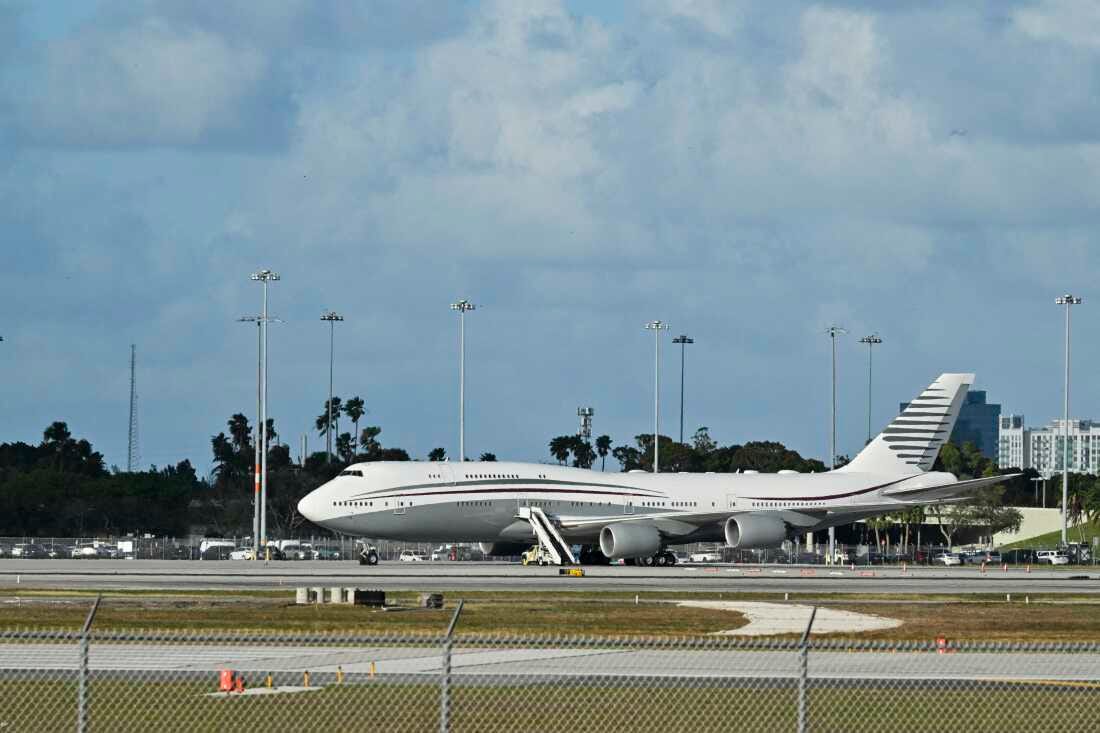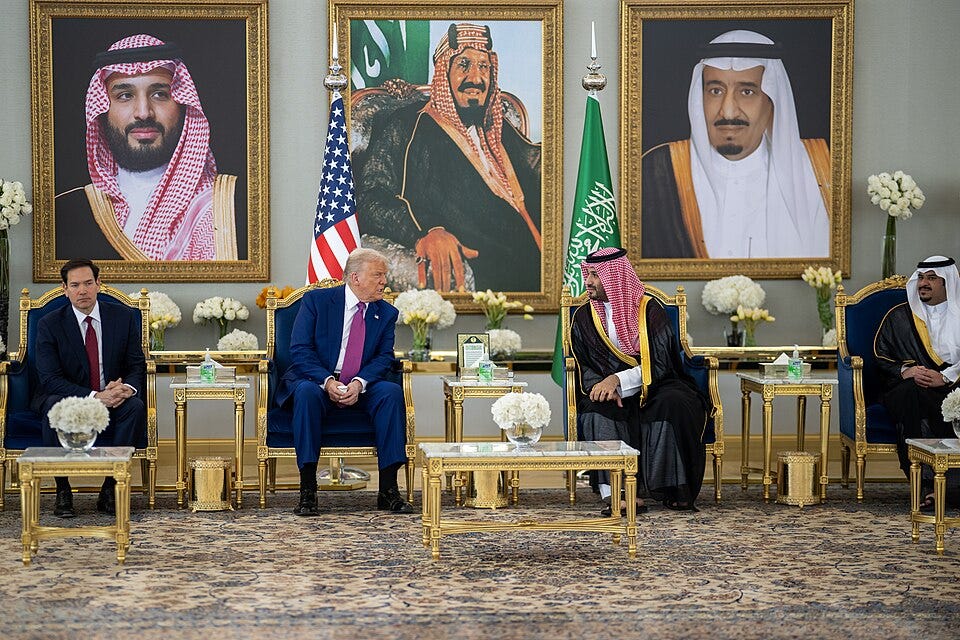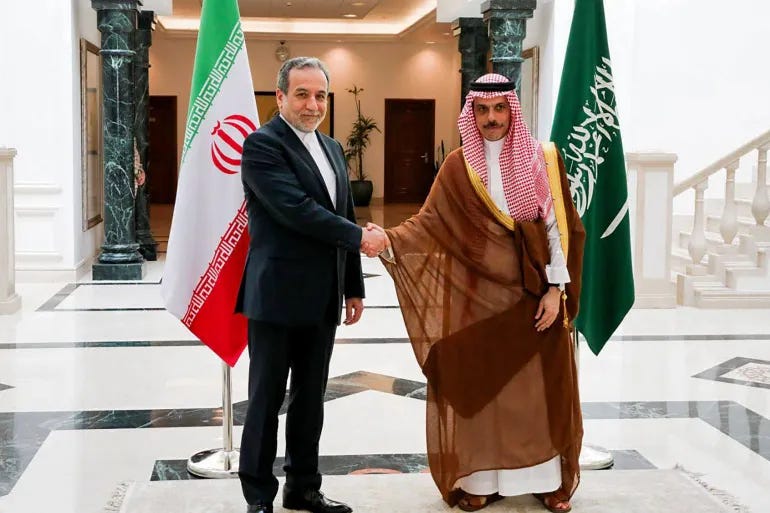Deals Over Doctrine
Trump’s Middle East Tour
President Donald Trump’s four-day Middle East tour earlier this month was a notable departure from past U.S. policy in the region. After decades of military entanglement and diplomacy driven by national security and nation building, the United States is now signaling a different approach. The visits to Saudi Arabia, Qatar, and the United Arab Emirates focused not on alliances or values but on economic agreements.
The fall of Kabul in 2021 to the Taliban offered a wider lesson about the limits of U.S. state-building. That experience, coupled with the erosion of American leverage in Iraq, Syria, and Lebanon, has reshaped Washington’s priorities. The Trump administration is shifting its focus from political reform to economic engagement as the primary means of influence in the region and following up on the biggest diplomatic win from Trump’s first term: the Abraham Accords.
A Transactional Tour
Trump began his trip on May 13 in Riyadh, where he met with Crown Prince Mohammed bin Salman. The meeting produced a $600 billion investment framework, including $142 billion in U.S. defense acquisitions. These ranged from missile systems to industrial partnerships with American defense firms. The package also included support for Saudi initiatives in energy and data infrastructure.
Trump also used the Saudi stop to announce the lifting of U.S. sanctions on Syria. He met with the country’s interim president, Ahmed al-Sharaa, signaling early recognition of the transitional government formed after the fall of Bashar al-Assad. The administration has emphasized private investment, not state aid, as the primary mode of U.S. re-engagement in Syria.
On May 14, in Doha, Trump met with Qatari Emir Tamim bin Hamad Al Thani. They signed a $243 billion agreementthat included a $96 billion Boeing order and a $10 billion upgrade to Al Udeid Air Base. The base improvements will include new communications systems and dual-use aerospace facilities. Controversially, Qatar also unveiled a luxury $400 million Boeing 747 outfitted to serve as Air Force One for President Trump, with plans to donate to his presidential library after leaving office. Even some Trump supporters have criticized this as corrupt.

The trip concluded on May 15 in Abu Dhabi. Trump met with UAE President Mohamed bin Zayed and announced a $14.5 billion package focused on aircraft procurement and the launch of a U.S.-Emirati artificial intelligence data center. The center will serve as a regional platform for American firms working in logistics, security, and digital infrastructure.
Altogether, the trip produced over $2 trillion in pledged deals. While much of that remains on paper, the intent is clear. The administration seeks to position U.S. firms at the center of Gulf economies as they invest in modernization and diversification away from economies driven by oil exports.
Commercial Statecraft
The delegation leading the trip was notable for who was included and who was not. Traditional diplomats played a limited role. The visit was anchored by a US-Saudi investment forum attended by Elon Musk, Blackrock CEO Larry Fink, and other business leaders. This reflected the approach of the trip: business-driven, high-level, and focused on securing commercial access.
In the monarchial Gulf states, where relationships carry more weight than process, this strategy yielded quick results on paper. But the absence of formal diplomatic channels creates uncertainty. Personal rapport can close deals fast, but it may not provide the stability required to sustain them over time through leadership changes. $2 trillion of investments will take years to come to fruition, well beyond the end of Trump’s second term.
Trump’s tour took place against a backdrop of regional upheaval. In Syria, the fall of Assad has created a power vacuum and an opportunity. By removing sanctions and signaling investment, the administration is attempting to shape the country’s future through early economic engagement. Whether this will build meaningful leverage or merely enable a new authoritarian structure remains to be seen.
Iran’s regional influence has also declined significantly. Hezbollah and Hamas have been sidelined as major security threats. Iranian-aligned militias in Iraq are divided and increasingly constrained by the central government. During the trip, Trump blocked an Israeli military strike on Iran’s nuclear facilities while reopening negotiations. The admin could be pursuing an opening to end the long-running proxy war between Iran and its Sunni Arab neighbors.
Gaza, while not a direct focus of the tour, was part of the strategic backdrop. Trump’s team has supported a framework in which Arab states would fund reconstruction efforts if Hamas were removed from power. The U.S. role would be indirect and financial, not political. While this may align with regional priorities, it raises questions about whether infrastructure investment alone can produce stability and end a humanitarian catastrophe.
A Different Kind of Diplomacy
This tour did not update earlier diplomatic agreementss; it departed from them entirely. The Abraham Accords, signed during Trump’s first term, were the product of extended negotiations and built on security cooperation. By contrast, the 2025 tour prioritized personal diplomacy and economic investments. It favored speed over process, and transactions over treaties.
Supporters of this approach argue that it reflects the realities of the moment. The United States no longer sees policing the region or remaking its politics as a pressing interest. Economic interdependence, they contend, is a more sustainable and effective form of influence, especially with the new reality of U.S. energy independence. Critics counter that it risks entrenching authoritarian regimes, sidelining human rights concerns, and leaving U.S. commitments vulnerable to collapse if deals unravel or leaders change.
Trump’s Middle East tour signaled a clear shift in American engagement. It did not emphasize democracy or human rights. It centered on economic leverage. Whether this approach proves effective over time is an open question. If these agreements are implemented and deepen regional ties, they may offer a new model for influence. If they remain aspirational or collapse under political strain, they may come to represent another failed attempt to impose a new order on a region that resists it.
For now, the strategy reflects a broader evolution in U.S. foreign policy, one where presence is measured not by troop deployments or alliances, but by the investments and infrastructure left behind.




